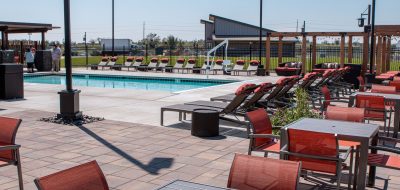By Lynn Difley
 Last week I received a question from one of our readers that I think might interest others as well. She said she has back problems, and access to a small pool, so what should she do? For starters, this is a great combination. If you have a bad back, or a back that acts naughty at times, one of the best treatment plans is to exercise in water.
Last week I received a question from one of our readers that I think might interest others as well. She said she has back problems, and access to a small pool, so what should she do? For starters, this is a great combination. If you have a bad back, or a back that acts naughty at times, one of the best treatment plans is to exercise in water.
Depending on the nature of your problem, water exercise may be the best, or indeed the only option. The buoyancy of your body in water means that there is very little impact when your feet touch the ground, as opposed to a lot of impact during some other exercise options such as running, jumping, or even jogging.
If you have spinal problems, find a pool you can work out in on a regular basis to incorporate both back strengthening moves and exercise, which increases blood flow and encourages healing. If you can, use a pool that is deeper than you are tall, and use a buoyancy belt so that you are suspended. Maintaining a vertical position in deep water requires core strength and challenges the whole torso section to find a balance that enables the body to maintain vertical positioning while current, ebb and flow of water, and body limbs serve to upset the balance.
Let’s say, however, that the pool you have access to–whether in your own backyard or one in a campground–is fairly shallow, from four to six feet deep. Water has 12 times the density of air, which means while you are exercising in water you are pushing and pulling with each move against a resistance, which makes it an excellent muscle strengthening workout.
You will need a pair of water shoes to protect the sensitive bottom of your feet from rough pool surfaces and to provide traction. Be sure also to use a sun hat, sunglasses, and a layer of sun block, since you’re going to be doing this on a regular basis. Perform all exercises with good posture, which is a healing practice for spinal problems.
- Start your exercise session with a slow march, swinging your arms and moving your legs through the water exactly as you would on land.
- Breathe deeply and set up a comfortable rhythm pattern between your feet and your breath.
- Walk forward and back, being sure to keep your torso erect. Imagine there is a string attached to the crown of your head, lifting you up towards the sky, while keeping your shoulders pressed down and back, and the breastbone lifting upward.
- Walk forward and back, across or around the pool, or zig zag, or make a square–just keep going. Just spend as much time walking backwards as you do forwards.
- Maintain a rhythmic gait, swinging your arms by your sides, keeping your abdominal muscles tight, and your posture erect.
- After 5 to 10 minutes of warm-up, you can speed up your walk and add a little variety, lifting the knees slightly higher, turning them out to the side, stepping wide (like through tires) or striding long. If any of these moves cause back pain- don’t do them, you are looking for healing and strengthening, not hurting.
- At first, walking backwards will seem awkward, but once you practice, you’ll find it is a great way to strengthen the muscles in the back of the body–the lesser used muscles. This will develop balance between the front and back muscles of the body and prevent some of the pain and injury that comes from having one set of muscles overpowering a weaker set.
Length of time? That’s up to you, but the heart association recommends a minimum of 20-30 minutes, 3-5 days a week. If you are new to exercise, start with 10 minutes, and add a minute each day until you reach a half-hour or more. I like to get the boom box out and put on a CD–a lively march, or good old tune that keeps me moving along briskly and helps the time to pass. That’s all there is to it, the rest is up to you. Let me know how you do.








Pingback: my url
John Rogers
There are alot of people that use pools for exercise and actually to help out back aches.
Chiropractor San Francisco
They say, when an exercise was done in a swimming pool or when the body is under the water, the exercise became more effective.